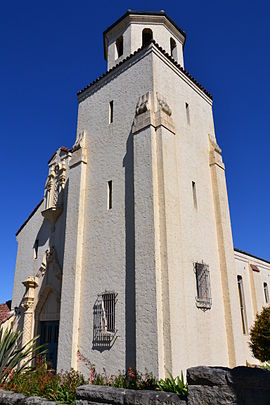Pymble, New South Wales
|
Pymble Sydney, New South Wales |
|||||||||||||
|---|---|---|---|---|---|---|---|---|---|---|---|---|---|

Ku-ring-gai Town Hall, formerly the Sacred Heart Catholic Church.
|
|||||||||||||
| Population | 10,582 (2011 census) | ||||||||||||
| • Density | 1,625.5/km2 (4,210/sq mi) | ||||||||||||
| Established | 1823 | ||||||||||||
| Postcode(s) | 2073 | ||||||||||||
| Area | 6.51 km2 (2.5 sq mi) | ||||||||||||
| Location | 16 km (10 mi) north-west of Sydney CBD | ||||||||||||
| LGA(s) | Ku-ring-gai Council | ||||||||||||
|
|||||||||||||
Pymble is a suburb on the Upper North Shore of Sydney in the state of New South Wales, Australia. Pymble is 16 kilometres (10 mi) north-west of the Sydney Central Business District in the local government area of Ku-ring-gai Council.
West Pymble is a separate suburb, surrounded by Lane Cove National Park.
Based on settlers' accounts the land that came to be known as Pymble was traversed by, and at least periodically inhabited by, what was by that time the "remains" of the Cammeraigal clan or tribe of the Kuringai (also known as Guringai) Aborigines. The Cammeraigal had occupied the land between the Lane Cove River, Hawkesbury and east to the coast. They would travel from grounds at Cowan Creek to the Parramatta River via Pymble - passing west through the land where Pymble Ladies' College now stands, through the Lane Cove Valley and North Ryde. En route they would reportedly hold corroborees at the current site of the Pymble Reservoir on Telegraph Rd and "camped on the hill...at the junction of Merrivale Rd and Selwyn St."
Pymble is named after Robert Pymble (1776–1861), an influential early settler whose 1823 land grant comprised some 600 acres, around half the land of the region. The other half (plus a large part of St Ives) was granted to Daniel der Matthew's, another influential settler who established the first sawmill in the area.
The region was important to the early Sydney colony as a major supplier of timber for a wide variety of uses. The main timber varieties were blackbutt, stringybark, iron bark and blue gum. In later years it was also an important supplier of agricultural produce. It became widely known for the high quality of its produce and especially for its oranges which had been introduced to the area by Robert Pymble sometime around 1828 and which by later years were grown extensively throughout the region by numerous different growers following land sub-divisions.
...
Wikipedia
